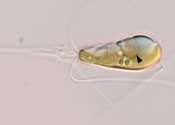Hubble finds far-away planet vanishing at record speed
The speed and distance at which planets orbit their respective blazing stars can determine each planet's fate—whether the planet remains a longstanding part of its solar system or evaporates into the universe's dark graveyard ...









